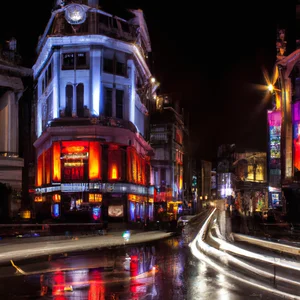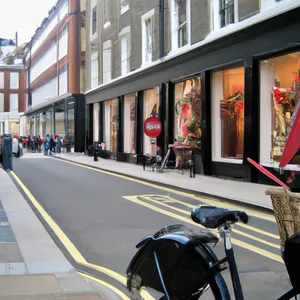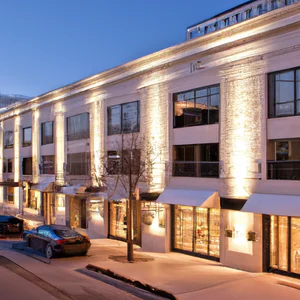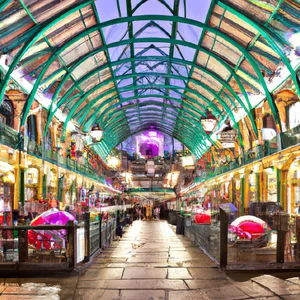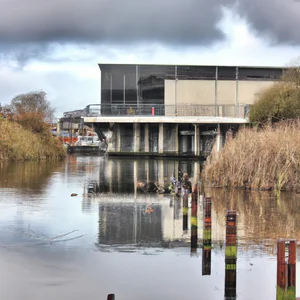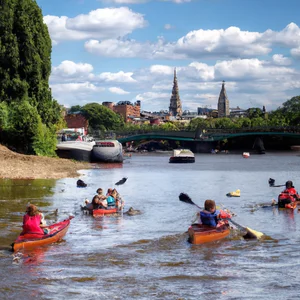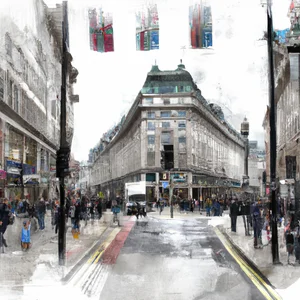Book your experience
Bloomsbury: the literary district of London, between museums and Georgian squares
Ah, Bloomsbury! That part of London that seems like something out of a novel. It’s like a corner of tranquility in the middle of the hustle and bustle of the city. I mean, if you’re a literature lover, this place is a bit like heaven on Earth, right?
When you walk through those streets, you almost feel like you can hear the echo of the words of great writers who lived there. And I’m not just talking about famous names, like Virginia Woolf or Charles Dickens, but also about all those little geniuses of the pen that maybe you don’t know so well. It’s as if every corner has a story to tell.
And let’s not forget the museums! There are a lot of them, and each has its own charm. The British Museum, for example, is a true gold mine of culture. The first time I went, I spent hours getting lost among the antiquities, almost as if I were an explorer looking for treasure. Then there are the squares, the Georgian ones that seem to have come out of a painting, with their well-kept gardens and houses that tell stories of another time. It’s a bit like going back in time, but with a steaming coffee in hand!
Of course, sometimes I think it’s a bit overloaded with tourists, that’s all. I don’t know, maybe it might bother some people, but I find a certain charm in it. People stopping to take selfies in front of those beautiful buildings, well, it’s a bit like a culture festival, isn’t it?
Ultimately, if you happen to be in London, you absolutely cannot miss Bloomsbury. It’s a place that makes you want to read, write, and just dream. It may not be for everyone, but for me it is one of the places that make my heart beat. And who knows, maybe one day I’ll write a book about it, right there, sitting on a bench in those squares. Wouldn’t that be great?
Discover the secrets of the British Library
A Fortuitous Encounter between History and Modernity
I still remember the first time I crossed the threshold of the British Library. It was a gray London day, and while the sky was crying, I found myself immersed in a sea of historical books and documents. The library, an impressive modern structure, is a haven for lovers of literature and history. As I explored the rooms, I came across a small room dedicated to Shakespeare’s manuscripts. Hearing the rustle of the pages of an original work, knowing that those words had traveled through time, made my soul vibrate.
Practical Information and Updates
The British Library is located in King’s Cross and offers free access to many of its permanent exhibitions. However, to access special documents or collections, a free registration is required. I recommend you check the official website British Library for any special events and temporary exhibitions, which can further enrich your visit. The library is open every day, but I recommend visiting it during the week to avoid the weekend crowds.
Insider advice
If you want a unique experience, don’t forget to visit the Treasures Gallery, where some of the most precious documents in history are kept, including Leonardo da Vinci’s Codex and one of the copies of the Magna Carta. Since this gallery is often overlooked by those focusing on the more famous exhibits, you may find a quiet corner where you can reflect on the grandeur of history.
Cultural and Historical Impact
The British Library is not just a library; it is a living monument to culture and creativity. It houses over 170 million objects, from the 19th century to the present, and represents an important archive of our civilization. It is a place where the past and present intertwine, and where every visitor can discover the roots of critical thought and world literature.
Sustainable Tourism
Visiting the library is an act of responsible tourism. With its commitment to sustainability, the British Library promotes ecological practices and offers green spaces for those who want to escape to a corner of nature in the city. Choosing to visit on foot or by bike is one way to reduce your environmental impact and appreciate the beauty of the Bloomsbury neighborhood.
An Activity to Try
Don’t just explore the treasures on display: take part in one of the many workshops that the library offers, where you can learn to write with ink and pen, just like the great authors of the past did. It’s an opportunity to immerse yourself in an often forgotten art and to connect with other literary enthusiasts.
Myths and Misconceptions
A common misconception is that the British Library is only for scholars and researchers. In fact, it’s a welcoming place for everyone to explore, discover and be inspired. You don’t need to be an expert to enter and enjoy the beauty and history it exudes.
Final reflection
As you leave the British Library, I invite you to reflect on which stories have affected you most and how these influence your daily life. What book or document inspired you to look at the world with different eyes? Next time you find yourself in Bloomsbury, take the time to explore and uncover the secrets of this incredible literary neighbourhood.
Stroll through the Georgian squares
A Personal Experience in the Heart of London
When I first stepped into one of Bloomsbury’s Georgian squares, the sun was setting, turning the sky a warm orange as a light autumn wind caressed the golden leaves of the trees. As I walked along the cobbled pavements, I felt transported back in time, surrounded by elegant Georgian buildings, each with its own story to tell. The atmosphere was a perfect mix of tranquility and history, a corner of London where time seems to have stood still.
Practical Information
Georgian squares, such as Russell Square and Bloomsbury Square, are easily accessible by tube (nearest stations: Russell Square and Holborn). Don’t forget to also visit Tavistock Square, famous for its memorial garden and Gandhi statue. The squares are open to the public and entry is free, making this experience accessible to all. To obtain more detailed information, I recommend you consult the official Visit London website.
Insider advice
A little secret that only locals know is that in the early hours of the morning, the squares are incredibly quiet. I recommend taking a walk at dawn, when the gardens are shrouded in light fog and you can enjoy the beauty of the place without the hustle and bustle of tourists. It’s a perfect time to take evocative photos or simply to reflect.
Cultural and Historical Impact
Bloomsbury’s Georgian squares aren’t just beautiful to look at; they also represent an important cultural heritage. This area was a center of intellectualism and creativity in the 18th and 19th centuries, home to artists, writers and thinkers such as Virginia Woolf and Charles Dickens. Walking through these squares, you can almost hear the echoes of their conversations and the fervor of the ideas that have shaped modern thought.
Sustainability in Tourism
For those who care about the environment, the Bloomsbury neighborhood is an excellent example of sustainable tourism. Walking or cycling to explore these squares is an eco-friendly way to enjoy the beauty of the place, reducing your environmental impact. There are also several local initiatives promoting sustainable trade and artisanal art.
An Activity to Try
For an unforgettable experience, join one of the themed guided walks which focus on the Georgian history of the area. These visits will not only take you through the squares but also offer you fascinating tales and anecdotes about the historical figures who inhabited these streets.
Myths and Misconceptions
A common misconception is that Georgian squares are only for those who love architecture. In reality, these squares offer a variety of experiences, from art and literature to cultural events and markets. Don’t let their elegant facade fool you; there is much more to discover.
Final reflection
As you walk away from these historic squares, ask yourself: How many stories of everyday life took place in these spaces? Walking through the Georgian squares is not only a journey into the past, but also an opportunity to reflect on the human connections that have shaped our culture. We invite you to discover these stories and be inspired by the timeless beauty of Bloomsbury.
The house of Charles Dickens: a journey into the past
A soul that tells stories
I remember the first time I crossed the threshold of Charles Dickens’ house in London, a place that seemed to pulsate with life and creativity. The walls were full of stories, and every object on display seemed to have a soul. As I explored the rooms, I imagined the great novelist intent on writing “Oliver Twist” or “David Copperfield” in one of his favorite corners. The house, located at 48 Doughty Street, is Dickens’s only surviving residence to this day and offers a fascinating insight into Victorian life.
Practical information
The house is open to the public throughout the week, with opening hours that vary depending on the season. Entry costs around £9 for adults, but is free for children under 16. It is advisable to book tickets online through the official website Charles Dickens Museum to avoid long queues. During visits, museum experts offer guided tours that reveal the most fascinating details of Dickens’ life and works.
An insider tip
A little-known tip is to visit Dickens’ house on weekdays, when the flow of visitors is lower. This allows you to enjoy a more intimate visit, where you can really immerse yourself in the atmosphere and dedicate time to each room, each desk and each object.
The cultural impact of Dickens
Dickens’ house is not just a simple residence, but a monument to the literature and society of the time. Dickens used his writing to denounce social injustices and give voice to the less fortunate. His influence extends far beyond literature: he helped change public perception of the living conditions of the poorest strata of Victorian society. Visiting his home is a way to better understand the historical and cultural context in which he lived and wrote.
Sustainability and responsibility
When you visit Dickens’ house, try to adopt sustainable tourism practices. You can reach the museum on foot or by bicycle, exploring the surrounding neighborhood and its fascinating corners. Furthermore, the museum promotes events and activities that raise public awareness of contemporary social issues, keeping the spirit of Dickens alive.
An immersive experience
For a truly unique experience, attend one of the readings of Dickens’ works, which are held regularly in the museum. These events will allow you to listen to the words of the great author as if you had gone back in time, surrounded by his furniture and objects that tell the story of his life.
Myths and misconceptions
A common misconception is that Dickens’ house is exclusively a museum for literary figures. In fact, the attraction is for everyone: families, students and history buffs can find great value in exploring how one of the greatest novelists of all time lived and worked.
Final reflection
As you leave Dickens’s house, ask yourself: What story of everyday life could be told today, if only we had the courage to write it? Dickens’s house is not just a museum, but an invitation to look more deeply into our time and in our experiences, just as Dickens did in his.
Unusual museums: the Foundling Museum
An Unexpected Finding
The first time I crossed the threshold of the Foundling Museum, I felt as if I had entered a world apart, far from the hustle and bustle of London. It was a gloomy day, and the museum, located in an elegant Georgian building, exuded a welcoming warmth. As I explored the rooms, I discovered a fascinating story: that of a shelter for abandoned children, founded in 1739. Tears almost hit me when I saw the small wooden cards, used by parents to identify their children, left in custody to the museum. Each piece told a story of hope and desperation.
Practical Information
The Foundling Museum is located in the heart of Bloomsbury, easily accessible by tube (Russell Square stop). The museum is open Tuesday to Sunday, and entry is around £12 for adults. It is advisable to book in advance, especially on weekends. For more details, you can visit the official website Foundling Museum.
Insider advice
If you want an even deeper experience, take part in one of the creative workshops that the museum offers periodically. These workshops will allow you to explore themes related to the history of the institution, using artistic techniques that reflect the lives of the children welcomed here. An experience that is not only educational, but also therapeutic.
Cultural and Historical Impact
The Foundling Museum is not just a place for preserving memories; it is also a symbol of the fight against abandonment and the importance of community. In the 18th century, the Foundling Hospital provided a refuge for the most vulnerable, and its history influenced social policies across the United Kingdom. The collection of artworks, including pieces by artists such as William Hogarth and Thomas Gainsborough, not only celebrate beauty but also tell stories of resilience.
Sustainability and Responsibility
Visiting it is a step towards responsible tourism: the museum actively promotes initiatives to raise awareness of children’s rights and the importance of social protection. By supporting institutions like this, we help preserve important stories and ensure a better future for young people.
Immersion in the Atmosphere
Walking through the rooms of the museum is like leafing through a history book that comes to life. Every object, every photograph, whispers forgotten stories. The warm colors of the walls and the scent of ancient wood create an intimate atmosphere that invites reflection. Don’t forget to visit the museum café, which serves delicious tea and cakes, perfect for a contemplative break.
Recommended Activities
After your visit, I recommend taking a stroll through the surrounding gardens, where you can contemplate the beauty of nature and reflect on the stories you learned. Plus, explore Bloomsbury’s other attractions, such as the British Library or Charles Dickens’ home, for a day full of culture.
Myths and Misconceptions
A common misconception is that London’s museums are just for tourists. In fact, the Foundling Museum is also frequented by Londoners seeking to better understand their history and current social challenges. It is a place of learning and connection, open to all.
Final reflection
As you leave the Foundling Museum, we invite you to reflect on how the stories of abandoned children, once forgotten, can teach us about the importance of community and mutual support. What story will you take with you?
Historic cafés: enjoy a literary tea
An epiphany between the pages
I still remember the moment I entered one of the historic cafés of Bloomsbury, Gail’s Bakery, a place surrounded by an atmosphere of creativity and nostalgia. As I sipped an Earl Gray tea accompanied by a slice of lemon cake, the soft light of the pendant lamps illuminated the corners where writers and artists had found inspiration. Imagining the conversations that had taken place there, between the pages of unpublished novels and the dreams of a bygone era, made me feel part of a tradition that has its roots in time.
Practical information and local advice
The historic café scene in Bloomsbury is rich and varied, with venues such as the British Museum Café and The Coffee House, offering not only great teas, but also a selection of artisanal cakes. Most of these cafes are open from 8am to 6pm, making them the ideal place for a break during a day of exploring.
A little-known tip: Many cafes offer discounts for customers who bring along a reusable cup. This not only helps reduce waste, but can also transform your experience into a sustainable gesture.
Cultural and historical impact
These cafes are not simply places to have a cup of tea; they are spaces that have hosted some of the brightest minds in British literature. Charles Dickens, Virginia Woolf and T.S. Eliot are just some of the names who have found refuge and inspiration in these welcoming corners. The atmosphere you breathe is permeated with a history that continues to influence contemporary writers and artists.
Responsible and sustainable tourism
In the context of the growing attention towards sustainable tourism practices, choosing a café that uses local and organic ingredients is one way to support the local economy. Many of these cafés, in fact, are committed to reducing their environmental impact, using seasonal products and recycling practices.
An activity not to be missed
For a truly unique experience, try an afternoon tea in one of the historic cafés, where you can enjoy a selection of teas alongside scones, sandwiches and treats. At The British Museum Café, for example, they often organize special events linked to exhibitions or literary themes, creating a bridge between culinary and literary culture.
Myths and misconceptions
A common misconception is that these places are reserved for tourists only. In reality, Bloomsbury’s historic cafés are also frequented by locals, who gather there to work, read or simply chat. This creates a vibrant and authentic atmosphere, far from tourist clichés.
A final reflection
As you sip your tea, ask yourself: What stories could these walls tell if only they could talk? The next time you find yourself in one of these historic cafés, take a moment to savor not only the taste of your drink, but also the cultural and historical richness that surrounds you. Enjoying a literary tea is an invitation to immerse yourself in a world of words and ideas that continues to live on today.
Bloomsbury: a hub of creativity and culture
A personal experience in the heart of Bloomsbury
I remember the first time I set foot in Bloomsbury: a cool spring morning, the sun’s rays filtered through the leaves of the centuries-old trees, creating a play of light and shadow on the sidewalks. Walking along the cobbled streets, I couldn’t help but hear the echoes of laughter and conversations of intellectuals who once inhabited these areas. The sensation of walking in the footsteps of Virginia Woolf and the members of the Bloomsbury Group was palpable, almost magical.
Practical and up-to-date information
Bloomsbury, located in central London, is easily accessible by tube (nearest stop: Russell Square). The neighborhood is famous for its historic libraries, art galleries and green spaces. Don’t miss the chance to visit the British Museum, which houses collections from around the world and entry is free, although donations are always welcome.
An insider tip
If you want a truly unique experience, visit Gordon Square Garden at sunset. This park, often overlooked by tourists, is a lovely place for a quiet stroll or picnic. Locals love to gather here to discuss and share ideas, creating a vibrant and stimulating atmosphere. Bring along a book of poetry by a Bloomsbury Group author and be inspired by the context.
The cultural impact of Bloomsbury
Bloomsbury is much more than just a neighbourhood; it is a symbol of creativity and innovation. The famous Bloomsbury Group was born here, a collective of writers, artists and intellectuals who profoundly influenced 20th century British culture. The radical ideas and works of these pioneers challenged the social conventions of the time, making Bloomsbury a beacon of progressivism and freedom of expression.
Sustainable tourism practices
For a more responsible approach, explore the neighborhood on foot or by bike. The streets of Bloomsbury are perfect for a stroll and will allow you to discover hidden corners, such as small independent bookshops and historic cafés. Additionally, many of the attractions are close together, reducing the need for polluting transportation.
Immerse yourself in the atmosphere of Bloomsbury
Imagine walking through elegant Georgian squares, surrounded by ivy-covered historic buildings, as the scent of freshly brewed coffee mixes with the fresh air. Every corner tells a story, and Bloomsbury’s architectural beauty is a draw for lovers of culture and history. The sounds of lively conversations in cafes and the rustle of pages being turned in bookstores create a melody that fills the neighborhood.
An unmissable activity
Dedicate an afternoon to visiting the Charles Dickens Museum, located in the author’s home. As well as exploring the rooms where Dickens lived and wrote, attend one of the readings of excerpts from his works, an experience that will make you feel like you’ve stepped back in time.
Myths and misconceptions
A common misconception is that Bloomsbury is only for intellectuals and scholars. In reality, the neighborhood is accessible to all and offers experiences for every type of visitor, from artists to history buffs. Don’t be put off by the idea that it’s an exclusive place; on the contrary, Bloomsbury is a melting pot of cultures and ideas.
Final reflection
As you explore Bloomsbury, ask yourself: What does creativity mean to me? This neighborhood is not just a place to visit, but an invitation to reflect on your relationship with art and culture. Every step along these historic streets is an opportunity to inspire yourself and rediscover the power of ideas. There’s no better way to connect with London’s rich cultural heritage.
Literary events: participate in unique readings
A charming soul in a corner of Bloomsbury
I vividly remember the first time I attended a literary reading in a small café in Bloomsbury. The atmosphere was intimate, the wooden tables creaked under the weight of cups of steaming tea and the scent of fresh pastries filled the air. That evening, a young author revealed his debut novel, and each word seemed to dance delicately in the air, enveloping the audience in an embrace of stories and emotions. It’s at these events that you feel the creative heartbeat of London, a unique opportunity to connect with emerging writers and hear stories that might otherwise remain in the pages of a book.
Practical information
Bloomsbury is famous for being a center of attraction for literary events. Places like the British Library and Rich Mix host regular readings, talks and book launches. For to stay updated, it is useful to follow the social pages of various cultural spaces and independent bookshops, such as Hatchards, the oldest bookshop in London, which frequently organizes meetings with authors. You can also check out the London Literature Festival website for special events throughout the year.
An insider tip
A little-known tip is to look for readings in local pubs. Often, these places not only serve great beers and food, but also host poetry and story nights. The atmosphere is less formal than a bookstore or theater, and the connection between the author and the audience is palpable. Don’t forget to check out The Poetry Café events calendar for nights that might surprise you.
The cultural importance
Literary events in Bloomsbury are not only a chance to hear new authors, but also a meeting point for different cultures and ideas. This neighborhood is historically linked to iconic literary figures such as Virginia Woolf and T.S. Eliot, and continues to be a crossroads of thought and creativity. Attending these readings is a way to immerse yourself in London’s cultural heritage and contribute to a tradition that celebrates the written word.
Responsible tourism
Participating in literary events is also a sustainable way of discovering the city. For example, many events take place in spaces accessible by foot or bicycle, encouraging visitors to explore the neighborhood responsibly. Furthermore, some events raise funds for local causes or for the promotion of literature in schools.
A magical atmosphere
Imagine sitting in a crowded room, the soft lights illuminating the author’s face as he tells the story that is most precious to him. Each word slips out like a whisper, and you find yourself laughing and getting emotional with the others present, all united by the power of storytelling. It’s an experience that goes beyond simple reading; it is a shared moment, a bond between the narrator and the audience.
An activity worth trying
For an authentic experience, try to attend an “Open Mic” event at one of Bloomsbury’s cafes. Here, anyone can take the stage and share their words, whether it’s poetry, short stories or simple reflections. Not only will you have the opportunity to discover new talent, but you may also find the courage to share your words.
Myths and misconceptions
A common misconception is that literary events are reserved only for experts or academics. In reality, they are spaces open to anyone who loves literature. The atmosphere is welcoming, and the diversity of the audience makes each event unique. You don’t need to be a literary critic to enjoy these experiences; all you need is curiosity.
A final reflection
Every time I attend a reading in Bloomsbury, I ask myself: how many unheard stories surround us? It’s an invitation to explore not only the world of literature, but also the life stories that animate this vibrant neighborhood. When will your next reading be?
Sustainability in tourism: exploring the neighborhood on foot
A step into the past
I vividly remember the first time I set foot in Bloomsbury. As I walked along the cobbled streets, surrounded by elegant Georgian buildings and manicured gardens, I realized that every step I took was not only a way to discover a neighborhood, but also a way to connect with its literary soul. Walking through Bloomsbury is like leafing through a novel, where each page reveals a new chapter in London’s cultural history.
Practical information
Bloomsbury is easily accessible by tube; Russell Square and King’s Cross stops are among the most convenient. Once there, it is advisable to forget about public transport and immerse yourself in the neighborhood on foot. The streets are full of life and history, perfect for a contemplative stroll. Don’t forget to visit the British Library’s official website and Visit London pages for current events and activities.
An insider tip
A curious way to explore Bloomsbury is to follow the path of the Blue Plaques, the blue plaques commemorating the homes of illustrious residents. While most tourists focus on the most famous sights, I advise you to look for lesser-known plaques. One of these is located at 46 Gordon Square, where the great writer Virginia Woolf lived. Discovering these details will help you see the neighborhood with new eyes.
The cultural impact of walking in Bloomsbury
Walking in Bloomsbury is not just a way to explore, but a form of reflection on the intellectual and artistic history that pervades the neighborhood. Every corner tells stories of encounters, debates and creations that have shaped British literature. The choice to explore on foot favors direct contact with the environment, encouraging a deeper interaction with the local culture.
Sustainable tourism practices
Taking a sustainable approach during your visit to Bloomsbury is easy and rewarding. In addition to walking, you can also join walking tours organized by local guides who focus on eco-friendly practices. These tours will not only allow you to discover the neighborhood, but will also contribute to responsible tourism, supporting the local economy.
An atmosphere to experience
As you stroll, let yourself be enveloped by the scent of flowers in the gardens and the sound of pages being turned in the historic cafés. Imagine the great writers who walked right where you are walking, deep in thought. Each step is an invitation to reflect, create and connect with the authenticity of this place.
An activity worth trying
For a unique experience, take one of the themed walking tours that focus on the literature and history of Bloomsbury. These tours, often led by industry experts, offer an opportunity to explore not only the monuments, but also the stories and curiosities that make this neighborhood an inexhaustible source of inspiration.
Myths to dispel
A common misconception is that Bloomsbury is an exclusively academic neighborhood reserved for students and intellectuals. In fact, its liveliness is palpable and accessible to all. Every visitor can find fascinating corners, welcoming cafes and cultural spaces that invite creativity and reflection.
A final reflection
As you walk the streets of Bloomsbury, ask yourself: what stories could you write, walking through this word-rich neighborhood? The beauty of Bloomsbury lies in its ability to inspire, to make us feel part of a timeless literary tradition, while invites you to contribute to this ever-evolving narrative.
The hidden history of Gordon Square
I still remember the first time I set foot in Gordon Square. It was a sunny day and, as I ventured through the flower-filled paths, I felt a particular energy in the air, as if every step brought me closer to a piece of history. It was here that many members of the Bloomsbury Group, including Virginia Woolf and John Maynard Keynes, gathered to discuss bold ideas and innovative designs. The green lawn, surrounded by elegant Georgian buildings, almost seems to whisper the secrets of those inspiring conversations.
A corner of literary history
Gordon Square is not just a park, but a true treasure chest of stories. The square is an integral part of the history of Bloomsbury, a neighborhood that has given rise to significant cultural and artistic movements. Here, ideas of freedom, progress and innovation took shape, influencing the literature and art of the 20th century. Today, you can stroll through the same gardens where the thinkers of the past debated each other, savoring a sense of continuity and inspiration.
An insider tip
If you want to discover a lesser-known aspect of Gordon Square, look for the small architectural details of the surrounding houses. Many of these buildings still host cultural associations and art studios today, and often open their doors for special events. Check local programs to attend exhibitions or readings taking place in this extraordinary historical context.
Sustainability at Gordon Square
In an era where sustainable tourism is increasingly important, Gordon Square represents an example of how to preserve historic beauty while respecting the environment. Many of the gardens are managed with eco-friendly practices, and visitors are encouraged to explore the neighborhood on foot or by bicycle, fully enjoying its atmosphere without polluting.
An invitation to reflection
As you sit on one of the benches in Gordon Square, let yourself be carried away by the thoughts and emotions that this place evokes. You might ask: What stories came to life here? What ideas are still shaping our world today? The beauty of Gordon Square lies not only in its past, but also in the potential it offers to anyone who stops there. It’s a place where history meets the present, inviting you to leave your mark on the literary world, just as the greats of the past have done.
Ultimately, every visit to Gordon Square is an opportunity to connect with the past and imagine the future. It’s not just a corner of Bloomsbury, but a portal to inspiration and creativity. So, next time you find yourself in London, don’t forget to spend some time here, where history and art intertwine in a timeless embrace.
Authentic experiences: markets and local crafts
An unforgettable encounter between colors and flavors
I still remember the first time I visited Camden Market. As I strolled through the stalls with the irresistible scent of street food, an origami vendor showed me how to fold a simple piece of paper into a cute little bird. That small interaction, a simple gesture of sharing, transformed my visit into an authentic and unforgettable experience. Camden isn’t just a market; it is a crossroads of cultures, histories and artisan talents that deserve to be explored.
Discover the beating heart of London
London’s markets, such as Borough Market and Brick Lane Market, offer a wide variety of fresh produce, traditional dishes and local crafts. Borough Market, for example, is open every day from Monday to Saturday and is a true mecca for food lovers, with stalls offering everything from artisanal cheeses to ethnic specialties. Don’t forget to savor the famous porchetta sandwiches at “The Italian Deli”, a delight that can’t be missed on your list.
If you want an unconventional tip, try visiting the markets during less crowded hours, such as early in the morning. You will have the opportunity to chat with the sellers and discover fascinating stories behind each product.
A journey through culture and history
London markets are not only places of commerce, but also custodians of traditions and cultures. The Brick Lane Market, for example, is famous for its Bangladeshi origins, offering a wide range of traditional dishes and crafts. Here, food is a vehicle of history and cultural identity, a way to celebrate London’s diversity.
Sustainability and responsibility in tourism
In an age where sustainability is key, visiting local markets is a responsible option. Many sellers are committed to using organic ingredients and fair trade practices, thus reducing environmental impact. Choosing to buy local products not only supports the community’s economy, but also contributes to greater environmental awareness.
Immersion in colors and sounds
Walking among the stalls, let yourself be enveloped by the vibrant atmosphere; listen to the sounds of vendors promoting their products, while the scent of spices and food envelops your senses. Each market has its own soul, a unique melody that tells stories of passion and creativity.
An unmissable activity
If you’re looking for an authentic experience, take part in a craft workshop at Spitalfields Market. Here, you can learn to make unique jewelery or ceramics, taking home not only a souvenir, but also a piece of your London experience.
Dispelling the myths
A common misconception is that markets are only for tourists. In fact, they are also frequented by locals looking for fresh produce and a lively atmosphere. Don’t be afraid to mix with the locals; the markets are the beating heart of London’s daily life.
A final reflection
As I reflect on my experience of London’s markets, I wonder: how often do we allow ourselves to explore the authentic side of a city? Next time you visit London, take the time to discover the markets and get involved in the stories that each stall has to tell. What awaits you around the corner?

 Architecture and Design
Architecture and Design Cities and Regions
Cities and Regions Culture and History
Culture and History Events and Festivals
Events and Festivals Fashion and Shopping
Fashion and Shopping Food and Wine
Food and Wine Nature and Adventure
Nature and Adventure Unique Experiences
Unique Experiences




















